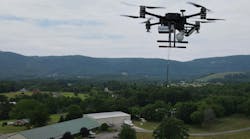WASHINGTON, 2 Nov. 2013. The Self-Powered Ad-hoc Network (SPAN), a wireless ground sensor system from Lockheed Martin in Bethesda, Md., will soon be able to connect with unmanned aircraft systems (UAS, also known as unmanned aerial vehicles or UAVs) to provide pervasive coverage and persistent surveillance of designated areas.
"SPAN is essentially a network of unobtrusive sensor nodes small enough to fit into the palm of your hand. Linking SPAN sensors with UAVs provides a cost-effective solution that can support many types of missions including force protection, border surveillance and regulatory and treaty compliance," describes Macy W. Summers, vice president with Lockheed Martin Information Systems & Global Solutions.
SPAN is incorporated with small devices that use energy-harvesting technology so the multi-purpose wireless sensor platform never needs a battery replacement, officials say. Using readily available energy sources in its surrounding environment, SPAN re-charges itself and its nodes do not transmit unless there is a sensor reading of concern.
Fusing SPAN with UAVs lowers the total cost of monitoring a specific area, since the SPAN networks automatically prompt UAV sensors without the need to depend on a separate operator alerting system. Each node, once placed on or in the ground in a mesh arrangement, transmits relevant data to the next node, and so on, until the information is ultimately forwarded to a wide area communications link.
During a UAV mission, the ground network automatically prompts the UAV's high-precision sensors to further characterize the alert without the need for a remote analyst. It enables UAV operators to focus on identified threats instead of loitering or flying pre-set mission profiles waiting for potential threats. The enhanced processing of timely intelligence enables responsive situational awareness for ground commanders in full spectrum and counter insurgency operations.




